The state joined the union on March 4, 1791 – State N0 14-24
https://en.wikipedia.org/wiki/Vermont
Mettre à jour
VERMONT, VT (14)
The state joined the union on March 4, 1791 – State N0 14-24
https://en.wikipedia.org/wiki/Vermont
Capital: Montpelier, VT
https://en.wikipedia.org/wiki/Montpelier,_Vermont
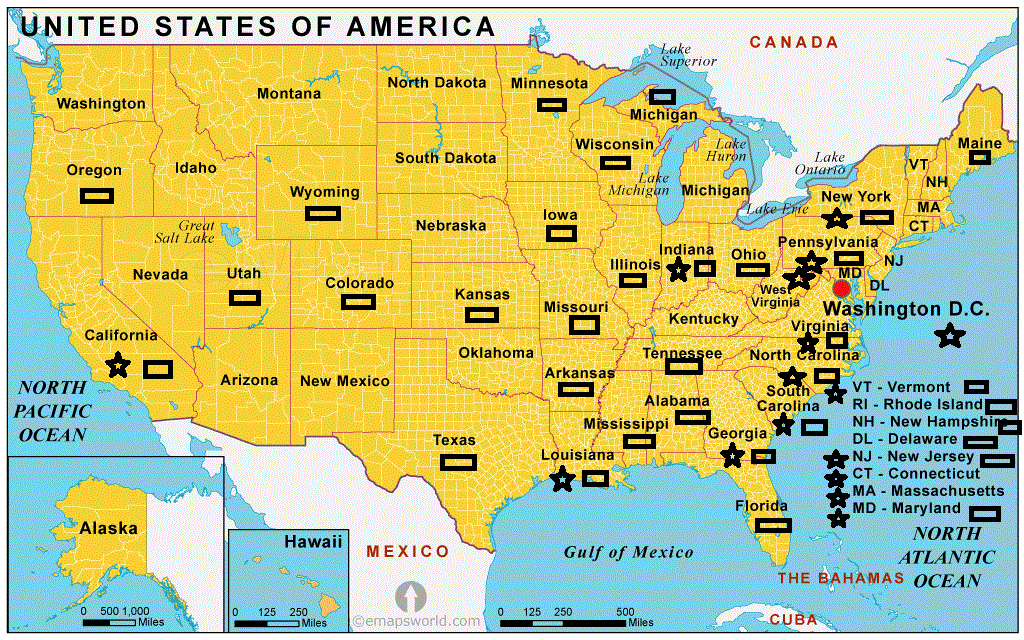
TOPIC I (T1) – OUTDOOR SCULPTURES IN VERMONT
Statues, Busts, Monuments, Memorials… Historic Parks and Places
Burlington, VT
https://en.wikipedia.org/wiki/Burlington,_Vermont
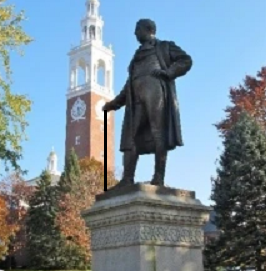
Lafayette statue recall that the Marquis de La Fayette had laid the cornerstone for the Old Mill during his visit in 1824 (By John Quincy Adams Ward (1883)
Today placed on the north end of the University of Vermont campus green (UVM).
(Go to TOPIC VII (T7) – LAFAYETTE’S FAREWELL TOUR (1824-1825) / Burlington, VT for more information).
TOPIC II (T2) – MANY PLACES…
Town, city, village, county, township … may refer or are named for
General Gilbert du Motier, marquis de La Fayette or the French involvement during the American Revolution.
Montpelier, VT – State Capital
https://en.wikipedia.org/wiki/Montpelier,_Vermont
The first permanent settlement began in May 1787, when Colonel Jacob Davis and his uncle General Parley Davis arrived from Charlton, MA. Colonel Davis selected the name « Montpelier » after the French city of Montpellier. At that time, there was general enthusiasm for things French as a result of the country’s aid to the American colonies during the Revolutionary War.
In 1825, the Marquis de Lafayette visited Montpelier on a triumphal tour of America, 50 years after the Revolutionary War.
Calais, VT
https://en.wikipedia.org/wiki/Calais,_Vermont
Colonel Jacob Davis named Calais after the French port city of the same name, during a time of general enthusiasm for things French as a result of France’s aid during the American Revolution.
Vergennes, VT
https://en.wikipedia.org/wiki/Vergennes,_Vermont
First settled in 1766 by Donald MacIntosh, Vergennes was established in 1788,
The city is named for Frenchman Charles Gravier, Comte de Vergennes, who greatly aided the rebel colonial effort in the American Revolutionary War. He supports the American rebel colonists by arranging to send them arms and troops to the revolutionary cause. He worked with Beaumarchais to secretly procure arms and volunteers and get them to the Americans. As directed by Louis XVI, Gravier established a dummy company through which the Americans received nearly 80% of their military supplies from France. At the close of the war, Gravier negotiated the 1783 Treaty of Paris, which formally established peace between the United States and Britain.
TOPIC III (T3) – STREETS, ROADS, SQUARES…
(Places, Parks, sites …)
Montpelier, VT – State Capital
(No street named for Lafayette found)
Burlington, VT
https://en.wikipedia.org/wiki/Burlington,_Vermont
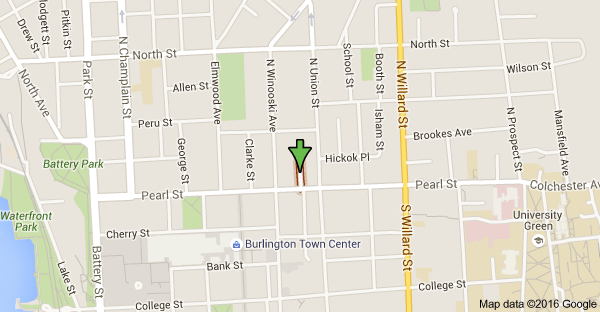
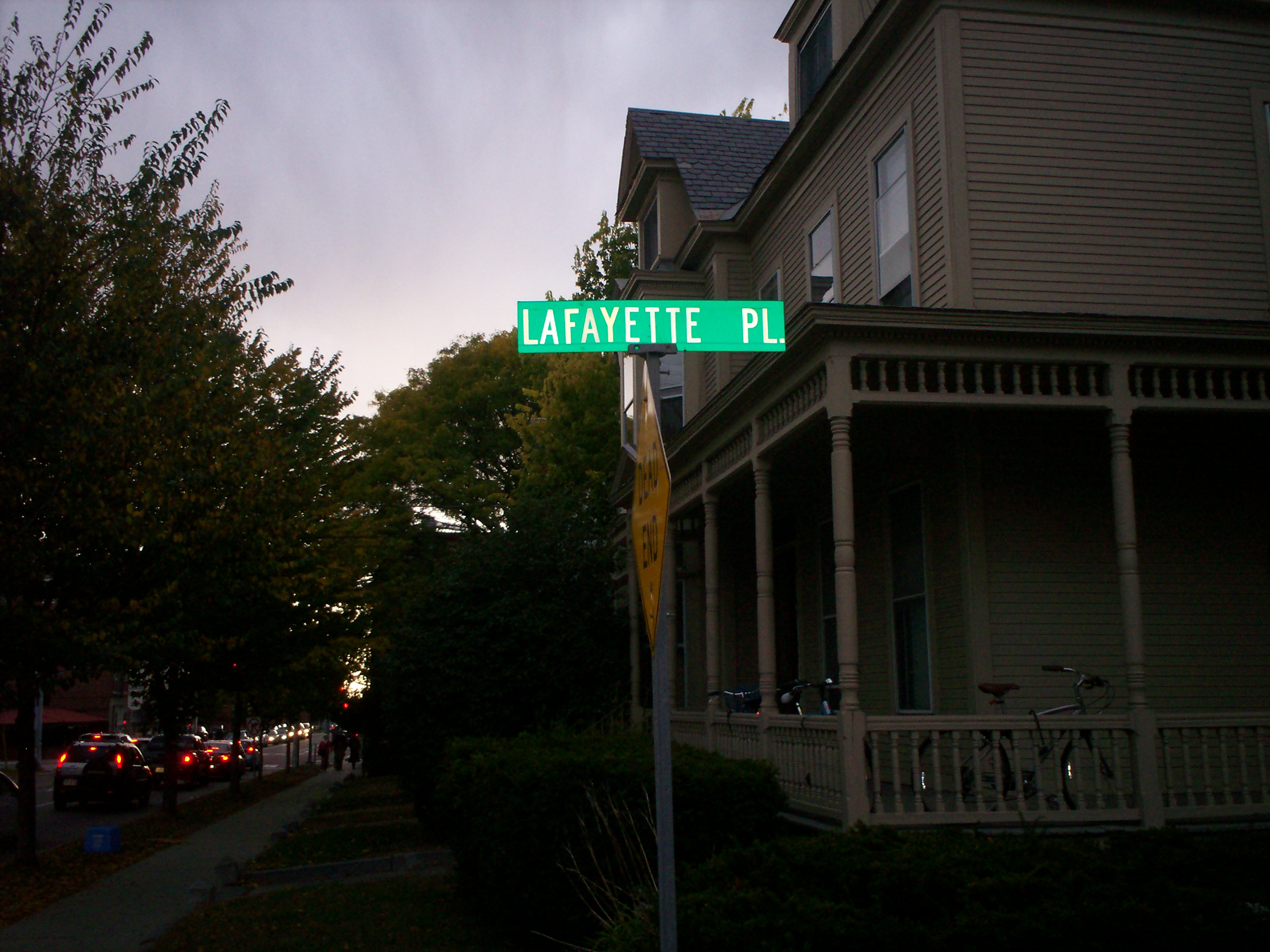
Lafayette Place (a dead-end street) at night!
Bristol, VT
https://en.wikipedia.org/wiki/Bristol,_Vermont
– Lafayette Rd.
Rutland City, VT
https://en.wikipedia.org/wiki/Rutland_(city),_Vermont
– Lafayette St.
St. Johnsbury, VT
https://en.wikipedia.org/wiki/St._Johnsbury,_Vermont
– Lafayette St.
South Burlington, VT
https://en.wikipedia.org/wiki/South_Burlington,_Vermont
– Lafayette dr.
TOPIC IV (T4) – INDOOR OBJECTS, MUSEUMS …
Pictures, busts, Exhibitions …
(No information found)
TOPIC V (T5) – LAFAYETTE AND FRANCE
THROUGHOUT THE COURSE OF THE AMERICAN REVOLUTION
They played a key role in the American Revolution (1765-1783)
and during the American Revolutionary War (1775–1783)
Between 1778 and 1783,
44 177 French soldiers and sailors fought aside the “American Insurgents”,
5 040 gave their lives for their independence.
Between 1776 and 1783, France spent 1.3 billion French pounds. A huge debt for the time that drained the Treasure of the Kingdom.
Road markers, places, objects…

The 13 English colonies
The 13 states involved: Connecticut, Delaware, Georgia, Maryland, Massachusetts (South and North), New Hampshire, New Jersey, New York, North Carolina, Pennsylvania, Rhode Island, South Carolina, Virginia.
LAFAYETTE INVOLVEMENT DURING THE AMERICAN REVOLUTIONARY WAR
He enlisted as a volunteer without pay alongside the « Insurgents » of the 13 English colonies in America who declared independence unilaterally July 4, 1776

Marquis de Lafayette as a Major General of Continental Army in 1779.
Portrait by Charles Willson Peale
*Lafayette: First military campaign: from June 1777 to January 1779
*Lafayette: Back in France to plead the cause of the “Insurgents”: from February 1779 to March 1780
* Lafayette: Second military campaign: from April 1780 to December 1781
FRANCE INVOLVEMENT DURING THE AMERICAN REVOLUTION

Louis XVI – King of France and Navarre
1768-1777 – France secretly helps the American Insurgents
1768: Baron de Kalb a Bavarian-born French military, traveled to America on a covert mission (to determine the level of discontent among colonists) on behalf of France.
1775-1776-1777: France secretly sent military supplies. During these three years, France had been sent secretly to the American rebels over five million “livres tournois” (French pound) of aid.
1778-1782 – France officially and fully aids the American Insurgents
1778 (February) – Franco American Treaty
(Later Spain (in 1779) and Dutch (in 1780) became allies of France)
*1778-1779 – 1st “French Expedition” under Comte d’Estaing
*1780-1781-1782- 2nd “French Expedition” under Comte de Rochambeau
*1781- The French Navy under Comte de Grasse joins the Franco-American ground Forces in Yorktown, VA
Vermont during the American Revolution was claimed by New York and New Hampshire states and was involved in the revolutionary war. It was almost the 14th States! Many French-Canadians where involves in the Revolutionary War.
Newbury, VT
https://en.wikipedia.org/wiki/Newbury_(town),_Vermont

The Bayley–Hazen Military Road was a military road that was originally planned to run from Newbury, VT, to St. John’s, Qc, not far from Montreal. 54 miles (87 km), running from Newbury, VT to Hazens Notch near the Canadian border, were constructed between 1776 and 1779 during the American Revolutionary War. Portions of the road’s route are used by modern roads today (From Wikipedia)
https://en.wikipedia.org/wiki/Bayley_Hazen_Military_Road
Go to page Canada/Quebec for more information
TOPIC VI (T6) – LAFAYETTE VISIT (August 4 to December 22, 1784)
Road markers, places, objects…

The United States 1783-1803
(No visit. The State did not exist in 1784)
In 1784, Lafayette visited all the 13 States of America except Georgia, where he enjoyed an enthusiastic welcome.
Go to the States visited: Connecticut, Delaware, Maryland, Massachusetts (South and North today Maine), New Hampshire, New Jersey, New York, North Carolina, Pennsylvania, Rhode Island, South Carolina, Virginia).
TOPIC VII (T7) – LAFAYETTE’S FAREWELL TOUR (1824-1825)
Road markers, places, objects…

The United States in 1825
The 24 states visited : Alabama, Connecticut, Delaware, Georgia, Illinois, Indiana, Kentucky, Louisiana, Maine (ex-Massachusetts / North part), Maryland, Massachusetts, Mississippi, Missouri, New Hampshire, New Jersey, New York, North Carolina, Ohio, Pennsylvania, Rhode Island, South Carolina, Tennessee, Vermont, Virginia. Plus Washington D.C.

Detailed Timeline
Lafayette visited New England: Massachusetts, MA Rhode Island, RI Maine, ME New Hampshire, N.H Vermont, VT and Connecticut, CT twice, spending a month all told in the region.
The First New England Visit (From August 20 to September 04, 1824)
From August 21 to August 24. Heading north from Staten Island, NY he stopped briefly in New Haven, CT, Providence, R.I, Stoughton, MA, and Boston, MA
On August 25 He arrived in Cambridge, MA
On August 26 he stopped in five Massachusetts cities and towns: Lexington, Concord, Salem, Marblehead, and Newburyport and settled into the Boston area until August 31. (During that time he visited former President John Adams in Quincy, MA.)
On September 1, he visited Portsmouth, N.H, then headed south again to Boston and Lexington, MA.
On Sept. 3. Worcester, MA, and Tolland, CT were on his agenda
On Sept. 4, Hartford and Middletown, CT was on his agenda
**
He then visited familiar places: Philadelphia, Delaware, Virginia. He spent some time in the new capital, Washington, D.C. then south to Maryland, the Carolinas, and Georgia. He turned west to see the new states of Alabama, Mississippi, and Louisiana, then up the Mississippi River in a steamboat to Missouri, Tennessee, Kentucky, Illinois, Indiana, and Ohio. Then he traveled back through Pennsylvania to New York, where he saw Niagara Falls and went to Albany by way of the Erie Canal. From Albany, he traveled straight to Boston.
**
Second New England Visit (From June 17 to June 29, 1825)
On June 17, 1825, Lafayette began his second New England tour by laying the cornerstone of the Bunker Hill Monument – Boston Mass
On June 23, Lafayette spent the night in Dover, N.H. That night, a delegation of citizens from South Berwick, ME, invited him to breakfast. He accepted. Then he visited Biddeford and Portland, ME
On June 27, he arrived late at night in Claremont, N.H.
33/33
On June 28, Early morning,
Early morning, Lafayette crosses into Vermont at the Cornish Bridge. He travels north, passing through Woodstock at 11 a.m., taking at Harland a stagecoach through the mountains to Barnard and Royalton, VT. He passes through Randolph; here he is said to have met a young Justin S. Morrill and eventual Senator Dudley Chase. He is escorted with Governor Cornelius P. Van Ness and others through Barre to large festivities in Montpelier, VT that include speeches by Supreme Court Judge Elijah Paine and others. He spends the night in Montpelier at The Pavilion.
Cornish-Windsor Covered Bridge, VT
https://en.wikipedia.org/wiki/Cornish%E2%80%93Windsor_Covered_Bridge
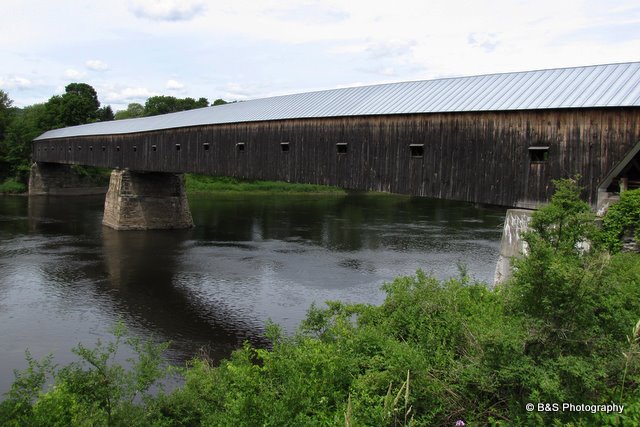
Cornish-Windsor Covered Bridge spans the Connecticut River connecting the towns of Windsor, VT, and Cornish NH
There were three bridges previously built on this site—one each in 1796, 1824 (used by Lafayette) and 1828. Image: Built in 1866, this is the longest wooden bridge in the US and the longest two-span covered bridge in the world.
Hartland, VT
https://en.wikipedia.org/wiki/Hartland,_Vermont
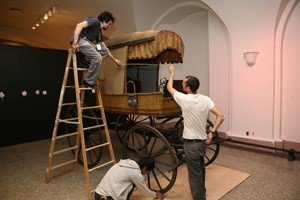
*The Lafayette coach: Lafayette takes a stagecoach through the mountains to Barnard and Royalton, VT.
In advance of an exhibition on a French aristocrat and military leader, Marquis de Lafayette, exhibit technicians at the New-York Historical Society prepare the carriage he rode from New Hampshire to Vermont in 1825.

Sumner Mansion
“The Lafayette Suite” Named for one of the most famous guests who stayed at the mansion in 1825, Marquis de La Fayette:
It is said that Lafayette became a friend of David Sumner when the latter was a Representative in Vermont. Benjamin Steele inherited the property upon the death of David Sumner, father of his wife Martha (Sumner). Martha Steele is credited with preserving the mansion and an original coach used by David Sumner and loaned to the Marquis de Lafayette on his visit to Vermont in 1825. She subsequently donated the coach to the Hartland Historical Society.
https://en.wikipedia.org/wiki/David_Sumner_House
Woodstock, VT
https://en.wikipedia.org/wiki/Woodstock,_Vermont

A reception was given to Lafayette in June 1825. Captain Issac Parker was present with his company
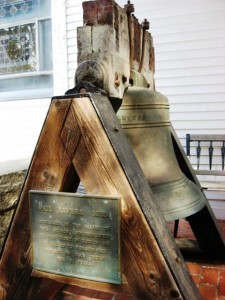
Woodstock holds the distinction of being the only town with five bells manufactured in the foundry established by Revolutionary War patriot Paul Revere (his father, was a French Huguenot born Apollos Rivoire born in Riocaud, France ). The Revere Bell, now displayed on the south porch, is the oldest of Woodstock’s bells and the only one cast in Paul Revere’s lifetime https://en.wikipedia.org/wiki/Paul_Revere
*Randolph, VT
Lafayette passes through Randolph; here he is said to have met a young Justin S. Morrill and eventual Senator Dudley Chase.
He is escorted with Governor Cornelius P. Van Ness and others through Barre
*Barnard, VT
*Royalton, VT
*Barre, VT
Montpelier, VT
https://en.wikipedia.org/wiki/Montpelier,_Vermont

“The Pavilion” reconstructed in 1876 where Lafayette spent a night on June 28, 1825

Plaque
On Wednesday, June 29, Lafayette meets with women’s groups and then departs Montpelier, VT for Burlington, VT, arriving there about 11:00am. He lays the cornerstone for the « South College » building at the University of Vermont and gives a talk to about 50-60 students. He is entertained at the Grass Mount estate.
Burlington, VT
https://en.wikipedia.org/wiki/Burlington,_Vermont
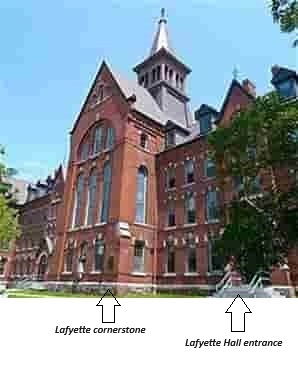
The Old Mill Building (historically known as the Main College Building) is the oldest campus building of the University of Vermont (UVM) and is located along the central eastern side of the « University Green » in Burlington, VT.
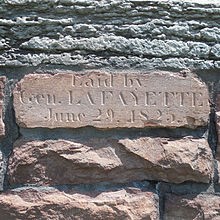
Cornerstone laid by Lafayette June 28, 1825
Original cornerstone of « South College » in Burlington
https://en.wikipedia.org/wiki/University_of_Vermont
On June 29, 1825, Lafayette departs from Burlington, VT 12 hours after he arrives.
He traveled overnight south on Lake Champlain past Mount Independence, Orwell, VT
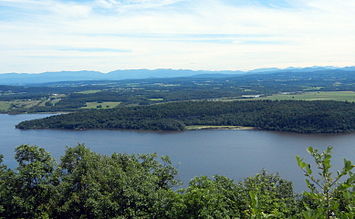
Mount Independence, as seen from across Lake Champlain
https://en.wikipedia.org/wiki/Mount_Independence_(Vermont)
on the steamboat Phoenix II
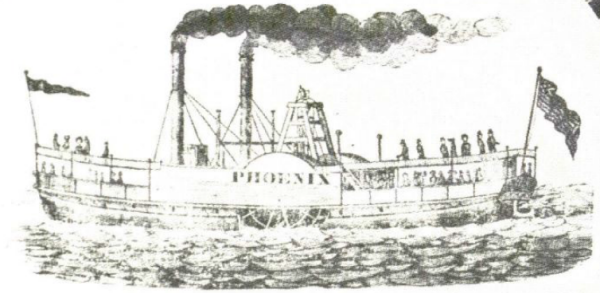
http://www.concordia.ca/cunews/offices/vpaer/aar/2017/08/07/discovery-in-a-steamboat-graveyard.html
and arrived Whitehall, NY June 30, 1825
Ouvrir les réglages du documentOuvrir le panneau de publication
- Page
Capital: Montpelier, VT
https://en.wikipedia.org/wiki/Montpelier,_Vermont

TOPIC I (T1) – OUTDOOR SCULPTURES IN VERMONT
Statues, Busts, Monuments, Memorials… Historic Parks and Places
Burlington, VT
https://en.wikipedia.org/wiki/Burlington,_Vermont

Lafayette statue recall that the Marquis de La Fayette had laid the cornerstone for the Old Mill during his visit in 1824 (By John Quincy Adams Ward (1883)
Today placed on the north end of the University of Vermont campus green (UVM).
(Go to TOPIC VII (T7) – LAFAYETTE’S FAREWELL TOUR (1824-1825) / Burlington, VT for more information).
TOPIC II (T2) – MANY PLACES…
Town, city, village, county, township … may refer or are named for
General Gilbert du Motier, marquis de La Fayette or the French involvement during the American Revolution.
Montpelier, VT – State Capital
https://en.wikipedia.org/wiki/Montpelier,_Vermont
The first permanent settlement began in May 1787, when Colonel Jacob Davis and his uncle General Parley Davis arrived from Charlton, MA. Colonel Davis selected the name « Montpelier » after the French city of Montpellier. At that time, there was general enthusiasm for things French as a result of the country’s aid to the American colonies during the Revolutionary War.
In 1825, the Marquis de Lafayette visited Montpelier on a triumphal tour of America, 50 years after the Revolutionary War.
Calais, VT
https://en.wikipedia.org/wiki/Calais,_Vermont
Colonel Jacob Davis named Calais after the French port city of the same name, during a time of general enthusiasm for things French as a result of France’s aid during the American Revolution.
Vergennes, VT
https://en.wikipedia.org/wiki/Vergennes,_Vermont
First settled in 1766 by Donald MacIntosh, Vergennes was established in 1788,
The city is named for Frenchman Charles Gravier, Comte de Vergennes, who greatly aided the rebel colonial effort in the American Revolutionary War. He supports the American rebel colonists by arranging to send them arms and troops to the revolutionary cause. He worked with Beaumarchais to secretly procure arms and volunteers and get them to the Americans. As directed by Louis XVI, Gravier established a dummy company through which the Americans received nearly 80% of their military supplies from France. At the close of the war, Gravier negotiated the 1783 Treaty of Paris, which formally established peace between the United States and Britain.
TOPIC III (T3) – STREETS, ROADS, SQUARES…
(Places, Parks, sites …)
Montpelier, VT – State Capital
(No street named for Lafayette found)
Burlington, VT
https://en.wikipedia.org/wiki/Burlington,_Vermont


Lafayette Place (a dead-end street) at night!
Bristol, VT
https://en.wikipedia.org/wiki/Bristol,_Vermont
– Lafayette Rd.
Rutland City, VT
https://en.wikipedia.org/wiki/Rutland_(city),_Vermont
– Lafayette St.
St. Johnsbury, VT
https://en.wikipedia.org/wiki/St._Johnsbury,_Vermont
– Lafayette St.
South Burlington, VT
https://en.wikipedia.org/wiki/South_Burlington,_Vermont
– Lafayette dr.
TOPIC IV (T4) – INDOOR OBJECTS, MUSEUMS …
Pictures, busts, Exhibitions …
(No information found)
TOPIC V (T5) – LAFAYETTE AND FRANCE
THROUGHOUT THE COURSE OF THE AMERICAN REVOLUTION
They played a key role in the American Revolution (1765-1783)
and during the American Revolutionary War (1775–1783)
Between 1778 and 1783,
44 177 French soldiers and sailors fought aside the “American Insurgents”,
5 040 gave their lives for their independence.
Between 1776 and 1783, France spent 1.3 billion French pounds. A huge debt for the time that drained the Treasure of the Kingdom.
Road markers, places, objects…

The 13 English colonies
The 13 states involved: Connecticut, Delaware, Georgia, Maryland, Massachusetts (South and North), New Hampshire, New Jersey, New York, North Carolina, Pennsylvania, Rhode Island, South Carolina, Virginia.
LAFAYETTE INVOLVEMENT DURING THE AMERICAN REVOLUTIONARY WAR
He enlisted as a volunteer without pay alongside the « Insurgents » of the 13 English colonies in America who declared independence unilaterally July 4, 1776

Marquis de Lafayette as a Major General of Continental Army in 1779.
Portrait by Charles Willson Peale
*Lafayette: First military campaign: from June 1777 to January 1779
*Lafayette: Back in France to plead the cause of the “Insurgents”: from February 1779 to March 1780
* Lafayette: Second military campaign: from April 1780 to December 1781
FRANCE INVOLVEMENT DURING THE AMERICAN REVOLUTION

Louis XVI – King of France and Navarre
1768-1777 – France secretly helps the American Insurgents
1768: Baron de Kalb a Bavarian-born French military, traveled to America on a covert mission (to determine the level of discontent among colonists) on behalf of France.
1775-1776-1777: France secretly sent military supplies. During these three years, France had been sent secretly to the American rebels over five million “livres tournois” (French pound) of aid.
1778-1782 – France officially and fully aids the American Insurgents
1778 (February) – Franco American Treaty
(Later Spain (in 1779) and Dutch (in 1780) became allies of France)
*1778-1779 – 1st “French Expedition” under Comte d’Estaing
*1780-1781-1782- 2nd “French Expedition” under Comte de Rochambeau
*1781- The French Navy under Comte de Grasse joins the Franco-American ground Forces in Yorktown, VA
Vermont during the American Revolution was claimed by New York and New Hampshire states and was involved in the revolutionary war. It was almost the 14th States! Many French-Canadians where involves in the Revolutionary War.
Newbury, VT
https://en.wikipedia.org/wiki/Newbury_(town),_Vermont
The Bayley–Hazen Military Road was a military road that was originally planned to run from Newbury, VT, to St. John’s, Qc, not far from Montreal. 54 miles (87 km), running from Newbury, VT to Hazens Notch near the Canadian border, were constructed between 1776 and 1779 during the American Revolutionary War. Portions of the road’s route are used by modern roads today (From Wikipedia)
https://en.wikipedia.org/wiki/Bayley_Hazen_Military_Road
Go to page Canada/Quebec for more information
TOPIC VI (T6) – LAFAYETTE VISIT (August 4 to December 22, 1784)
Road markers, places, objects…

The United States 1783-1803
(No visit. The State did not exist in 1784)
In 1784, Lafayette visited all the 13 States of America except Georgia, where he enjoyed an enthusiastic welcome.
Go to the States visited: Connecticut, Delaware, Maryland, Massachusetts (South and North today Maine), New Hampshire, New Jersey, New York, North Carolina, Pennsylvania, Rhode Island, South Carolina, Virginia).
TOPIC VII (T7) – LAFAYETTE’S FAREWELL TOUR (1824-1825)
Road markers, places, objects…

The United States in 1825
The 24 states visited : Alabama, Connecticut, Delaware, Georgia, Illinois, Indiana, Kentucky, Louisiana, Maine (ex-Massachusetts / North part), Maryland, Massachusetts, Mississippi, Missouri, New Hampshire, New Jersey, New York, North Carolina, Ohio, Pennsylvania, Rhode Island, South Carolina, Tennessee, Vermont, Virginia. Plus Washington D.C.
Detailed Timeline
Lafayette visited New England: Massachusetts, MA Rhode Island, RI Maine, ME New Hampshire, N.H Vermont, VT and Connecticut, CT twice, spending a month all told in the region.
The First New England Visit (From August 20 to September 04, 1824)
From August 21 to August 24. Heading north from Staten Island, NY he stopped briefly in New Haven, CT, Providence, R.I, Stoughton, MA, and Boston, MA
On August 25 He arrived in Cambridge, MA
On August 26 he stopped in five Massachusetts cities and towns: Lexington, Concord, Salem, Marblehead, and Newburyport and settled into the Boston area until August 31. (During that time he visited former President John Adams in Quincy, MA.)
On September 1, he visited Portsmouth, N.H, then headed south again to Boston and Lexington, MA.
On Sept. 3. Worcester, MA, and Tolland, CT were on his agenda
On Sept. 4, Hartford and Middletown, CT was on his agenda
**
He then visited familiar places: Philadelphia, Delaware, Virginia. He spent some time in the new capital, Washington, D.C. then south to Maryland, the Carolinas, and Georgia. He turned west to see the new states of Alabama, Mississippi, and Louisiana, then up the Mississippi River in a steamboat to Missouri, Tennessee, Kentucky, Illinois, Indiana, and Ohio. Then he traveled back through Pennsylvania to New York, where he saw Niagara Falls and went to Albany by way of the Erie Canal. From Albany, he traveled straight to Boston.
**
Second New England Visit (From June 17 to June 29, 1825)
On June 17, 1825, Lafayette began his second New England tour by laying the cornerstone of the Bunker Hill Monument – Boston Mass
On June 23, Lafayette spent the night in Dover, N.H. That night, a delegation of citizens from South Berwick, ME, invited him to breakfast. He accepted. Then he visited Biddeford and Portland, ME
On June 27, he arrived late at night in Claremont, N.H.
33/33
On June 28, Early morning,
Early morning, Lafayette crosses into Vermont at the Cornish Bridge. He travels north, passing through Woodstock at 11 a.m., taking at Harland a stagecoach through the mountains to Barnard and Royalton, VT. He passes through Randolph; here he is said to have met a young Justin S. Morrill and eventual Senator Dudley Chase. He is escorted with Governor Cornelius P. Van Ness and others through Barre to large festivities in Montpelier, VT that include speeches by Supreme Court Judge Elijah Paine and others. He spends the night in Montpelier at The Pavilion.
Cornish-Windsor Covered Bridge, VT
https://en.wikipedia.org/wiki/Cornish%E2%80%93Windsor_Covered_Bridge

Cornish-Windsor Covered Bridge spans the Connecticut River connecting the towns of Windsor, VT, and Cornish NH
There were three bridges previously built on this site—one each in 1796, 1824 (used by Lafayette) and 1828. Image: Built in 1866, this is the longest wooden bridge in the US and the longest two-span covered bridge in the world.
Hartland, VT
https://en.wikipedia.org/wiki/Hartland,_Vermont

*The Lafayette coach: Lafayette takes a stagecoach through the mountains to Barnard and Royalton, VT.
In advance of an exhibition on a French aristocrat and military leader, Marquis de Lafayette, exhibit technicians at the New-York Historical Society prepare the carriage he rode from New Hampshire to Vermont in 1825.

Sumner Mansion
“The Lafayette Suite” Named for one of the most famous guests who stayed at the mansion in 1825, Marquis de La Fayette:
It is said that Lafayette became a friend of David Sumner when the latter was a Representative in Vermont. Benjamin Steele inherited the property upon the death of David Sumner, father of his wife Martha (Sumner). Martha Steele is credited with preserving the mansion and an original coach used by David Sumner and loaned to the Marquis de Lafayette on his visit to Vermont in 1825. She subsequently donated the coach to the Hartland Historical Society.
https://en.wikipedia.org/wiki/David_Sumner_House
Woodstock, VT
https://en.wikipedia.org/wiki/Woodstock,_Vermont

A reception was given to Lafayette in June 1825. Captain Issac Parker was present with his company

Woodstock holds the distinction of being the only town with five bells manufactured in the foundry established by Revolutionary War patriot Paul Revere (his father, was a French Huguenot born Apollos Rivoire born in Riocaud, France ). The Revere Bell, now displayed on the south porch, is the oldest of Woodstock’s bells and the only one cast in Paul Revere’s lifetime https://en.wikipedia.org/wiki/Paul_Revere
*Randolph, VT
Lafayette passes through Randolph; here he is said to have met a young Justin S. Morrill and eventual Senator Dudley Chase.
He is escorted with Governor Cornelius P. Van Ness and others through Barre
*Barnard, VT
*Royalton, VT
*Barre, VT
Montpelier, VT
https://en.wikipedia.org/wiki/Montpelier,_Vermont

“The Pavilion” reconstructed in 1876 where Lafayette spent a night on June 28, 1825

Plaque
On Wednesday, June 29, Lafayette meets with women’s groups and then departs Montpelier, VT for Burlington, VT, arriving there about 11:00am. He lays the cornerstone for the « South College » building at the University of Vermont and gives a talk to about 50-60 students. He is entertained at the Grass Mount estate.
Burlington, VT
https://en.wikipedia.org/wiki/Burlington,_Vermont

The Old Mill Building (historically known as the Main College Building) is the oldest campus building of the University of Vermont (UVM) and is located along the central eastern side of the « University Green » in Burlington, VT.

Cornerstone laid by Lafayette June 28, 1825
Original cornerstone of « South College » in Burlington
https://en.wikipedia.org/wiki/University_of_Vermont
On June 29, 1825, Lafayette departs from Burlington, VT 12 hours after he arrives.
He traveled overnight south on Lake Champlain past Mount Independence, Orwell, VT

Mount Independence, as seen from across Lake Champlain
https://en.wikipedia.org/wiki/Mount_Independence_(Vermont)
on the steamboat Phoenix II

http://www.concordia.ca/cunews/offices/vpaer/aar/2017/08/07/discovery-in-a-steamboat-graveyard.html
and arrived Whitehall, NY June 30, 1825